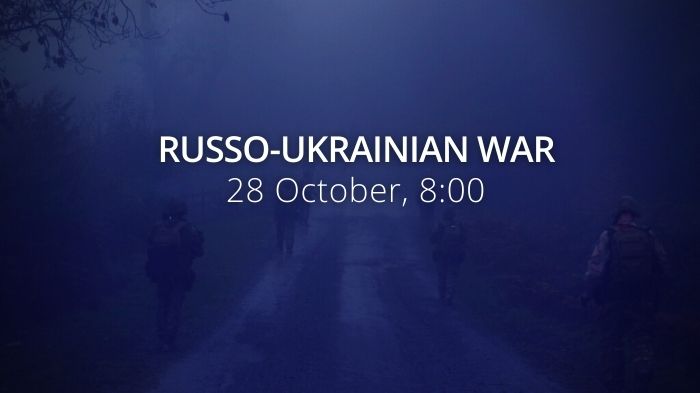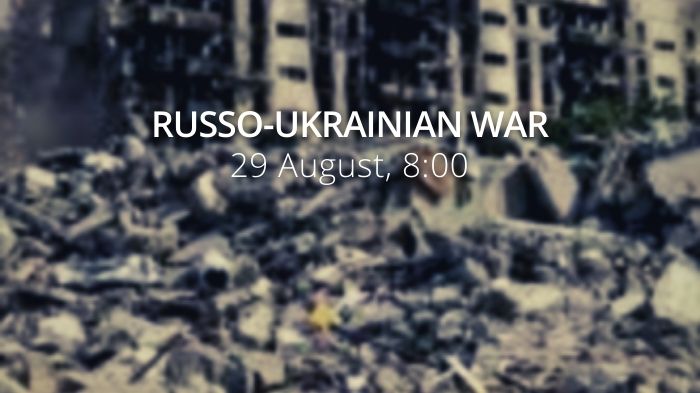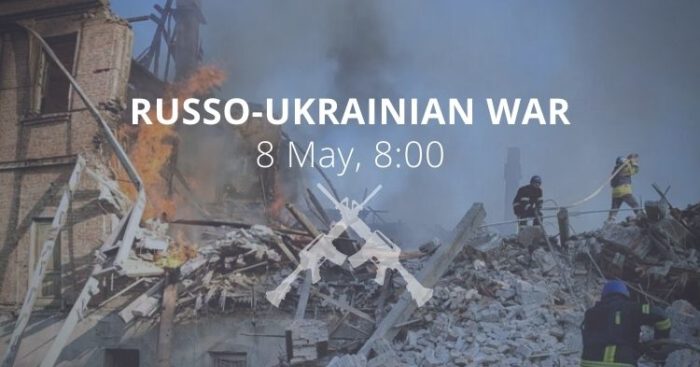Ukrainian forces continued to make advances north of Lyman and on the eastern bank of the Oskil River. Ukraine downed four "Shahed-136" kamikaze drones. Mobilized Russians call the hotline to ask how to surrender. Ukraine urges EU to help make emergency food routes permanent. Zelenskyy says two more burial sites were found in liberated Izium. Another Russian torture chamber was discovered in the Kharkiv region. US to allocate $457.5M in security assistance to Ukraine. UK sanctions collaborators of Russia's illegal sham referendums. Kazakhstan says it won't recognize Russian pseudo-referendums in Ukraine.
Daily overview — Summary report, September 27
A map of the approximate situation on the ground in Ukraine as of 00:00 27/09/22. pic.twitter.com/fTdAgKcbtp
— War Mapper (@War_Mapper) September 27, 2022
The General Staff’s operational update regarding the Russian invasion as of 06.00 am, September 27, 2022 is in the dropdown menu below.
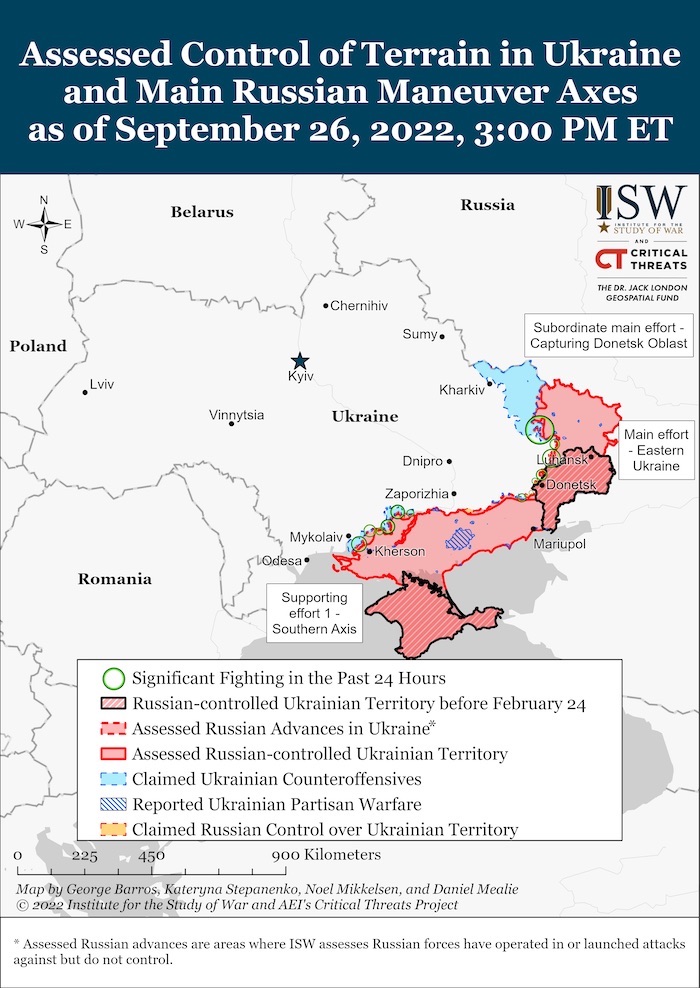
“Russian forces continue to focus their efforts on the full occupation of Donetsk region and holding the captured territories, as well as disrupting the active actions of the Defense Forces in certain areas. Shelling of the positions of our troops along the contact line continues, in some areas the occupiers are trying to restore lost positions, conducting aerial reconnaissance.
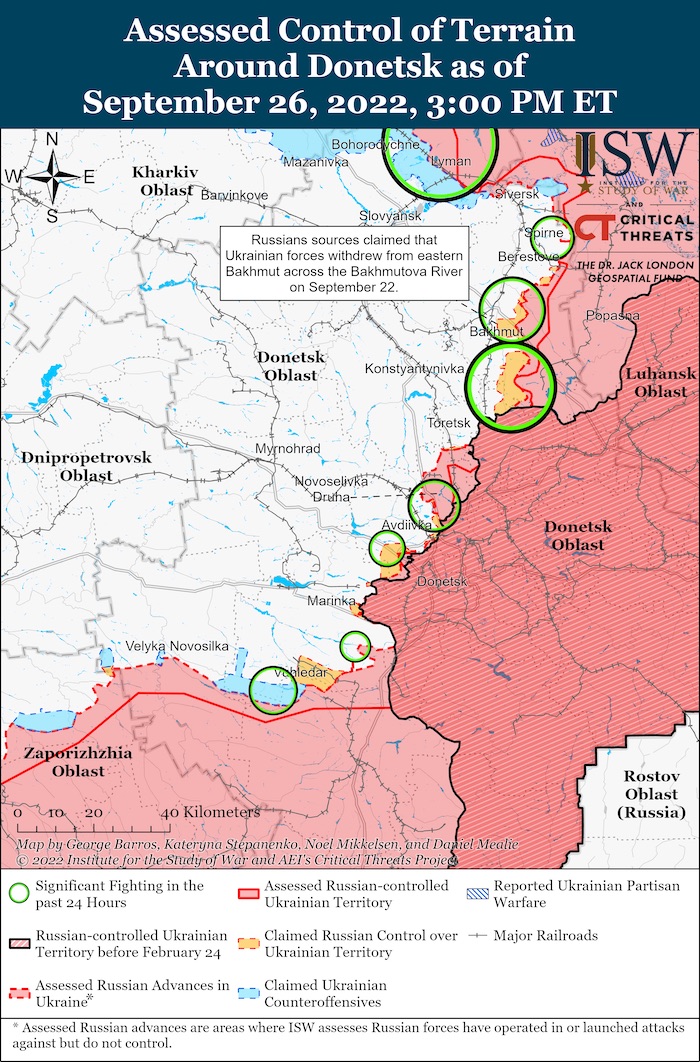
Russian forces attack the civilian infrastructure and the homes of the civilian population, violating the norms of International Humanitarian Law, the laws and customs of war.
The threat of air and missile strikes on the entire territory of Ukraine remains. Over the past day, Russian forces launched 9 missile strikes, 22 airstrikes and carried out more than 90 MLRS attacks. Russian forces used attack UAVs in the area of Bilenke settlement of the Odesa region.
More than 50 settlements were affected by the fire. Among them are Sloviansk, Kramatorsk, Soledar, Avdiivka, Novopil, Zaporizhzhia, Marganets, Musiivka, Kryvyy Rih, Nikopol, Potemkine, Osokorivka, Mykolaiv, Ochakiv and Bilenke.
The situation has not changed significantly in the Volyn, Polissia and Siverskyy directions.
In other directions, Russian forces continued shelling from tanks, mortars and artillery, namely:
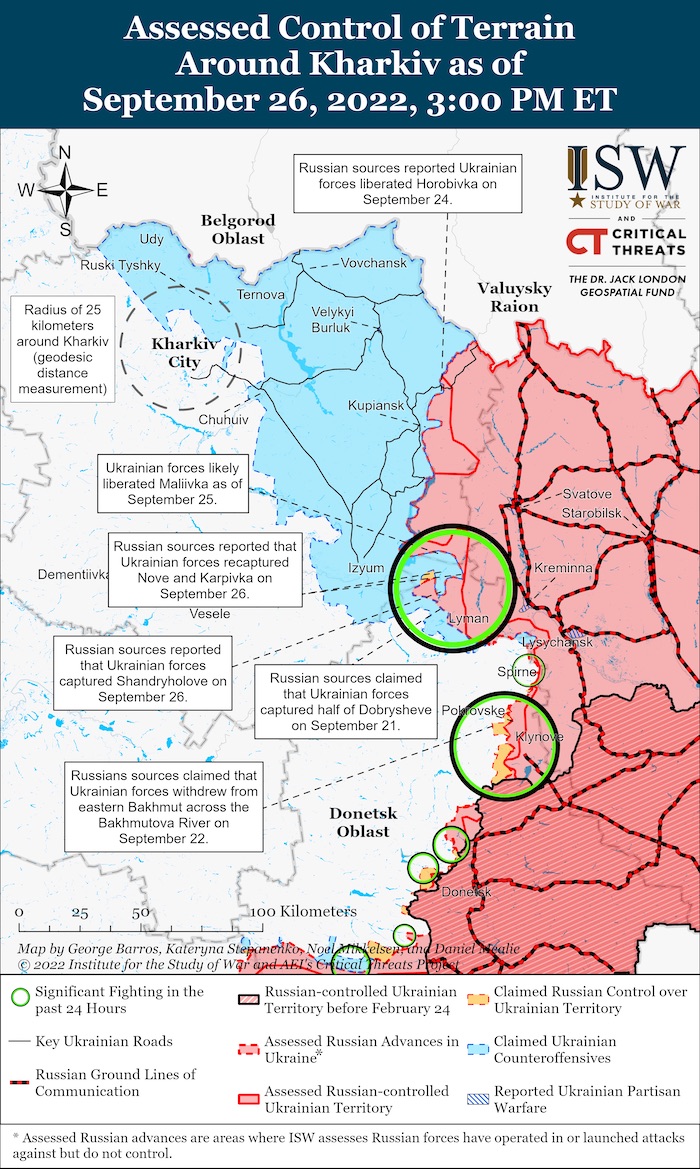
- in the Slobozhanskyy direction - in the areas of the settlements of Baranivka, Udy, Gatishche, Vovchansk, Dvorichne, Kucherivka, Petropavlivka and Senkove;
- in the Kramatorsk direction – Staryy Karavan, Ozerne, Siversk, Spirne, Rozdolivka and Vesele;
- in the Bakhmut direction - Soledar, Bakhmutske, Hryhorivka, Bakhmut, Vesela Dolyna, Zaitseve, Mayorsk and Yuryivka;
- in the Avdiivka direction – Avdiivka, Vodiane, Opytne, Krasnohorivka, Mariinka and Novomykhailivka;
- in the Novopavlivka direction – Zolota Niva, Vugledar, Pavlivka and Yehorivka;
- in the Zaporizhzhia direction - Novopillia, Novosilka and Vremivka.
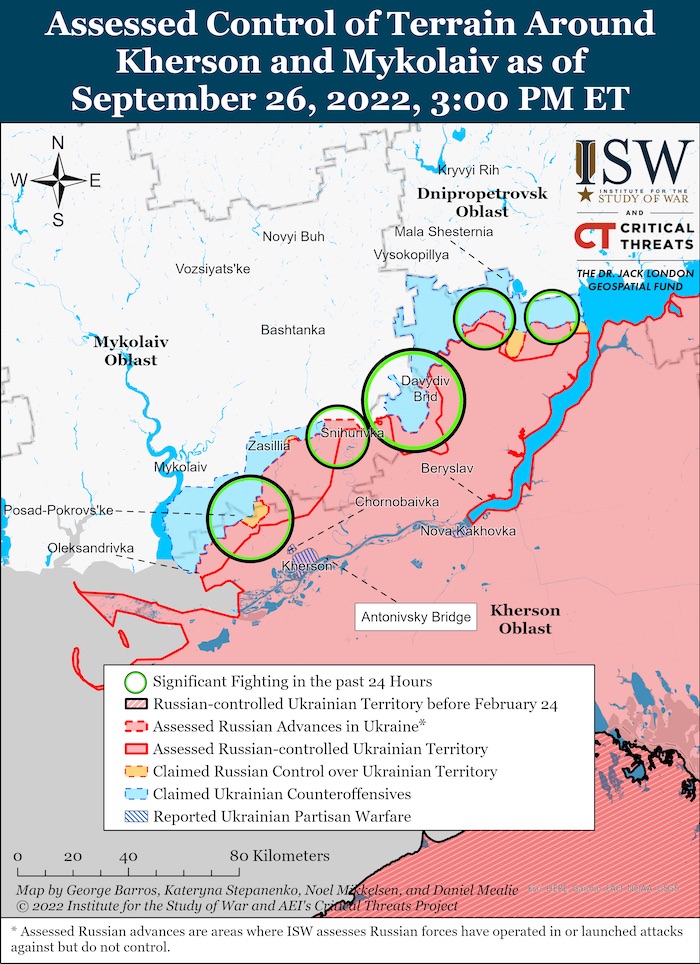
- in the Pivdenny Buh direction - More than 25 settlements near the contact line were hit by artillery and mortar shelling. In particular, Chervona Dolyna, Shyroke, Andriivka, Biloghirka, Ternovy Pody, Lymany and Myrne.
The situation at Zaporizhzhia NPP remains tense. Station employees do not want to cooperate with Russian forces and try to leave the territories temporarily occupied by the occupiers. The occupied part of the Kherson region is completely closed for entry and exit.
[Russian forces are strengthening filtering and counter-sabotage measures. Considerable attention is paid to checking the personal mobile phones of local residents for cooperation with the Defense Forces of Ukraine.]
The successful defeat of Russian personnel and equipment in the previous days has been confirmed. Thus, in Kherson, seven Ural trucks were destroyed and disabled, in Melitopol up to 10 units of weapons and military equipment and more than 20 occupants were destroyed. In the Tokmak and Chernihivka settlements of the Zaporizhzhia region, an enemy S-300 complex, 5 units of military equipment were destroyed and more than 50 occupants were wounded.
During the day, units of the Defense Forces repelled enemy attacks in the areas of Soledar, Kurdyumivka, Zaitseve, Mayorsk, Bakhmut, Kamianka, and Pervomaiske. [Yesterday, Ukrainian soldiers repelled enemy attacks in the areas of Spirne, Soledar, Pidhorodne, Bakhmut, Mayorsk, Kamianka, Pobyeda and Pavlivka settlements.]
Aviation of the Defense Forces made 28 strikes. Damage to more than 20 areas of accumulation of enemy manpower and military equipment and 7 positions of anti-aircraft missile systems was confirmed. Enemy losses are being clarified.
Missile troops and artillery hit 5 control points, 12 areas of accumulation of enemy manpower and equipment, 2 positions of anti-aircraft missile systems, 3 warehouses with ammunition, as well as more than 10 separate important targets.”
Military Updates
Military infrastructure hit by Russian drones in Odesa Oblast
Civilians are beung evacuated due to detonation of ammunition and fire. The type of drone has not been reported, but Iran's Shahed 136, already used in 2 attacks on Odesa, is likelyhttps://t.co/ubTFXkHXGE pic.twitter.com/Oi6GKjRMEm
— Euromaidan Press (@EuromaidanPress) September 26, 2022
Ukraine downed four "Shahed-136" kamikaze drones, the Ukrainian General Staff reports. “During the day, on September 26, units of the anti-aircraft missile forces of the "Southern" Air Command of the Air Force of the Armed Forces of Ukraine destroyed four "Shahed-136" kamikaze drones that attacked Odesa.
One of these barrage munitions was destroyed around 2 am. Three more "Shahed-136" attacked Odesa closer to 10:00 p.m. All three kamikaze drones were also destroyed by the forces and means of anti-aircraft guns of the "South" air command.”
https://twitter.com/EuromaidanPress/status/1574425462930972672
https://twitter.com/EuromaidanPress/status/1574385568716406787
According to British Defence Intelligence, (last 48 hours):
- President Putin is scheduled to address both houses of the Russian parliament on Friday 30 September.
- There is a realistic possibility that Putin will use his address to formally announce the accession of the occupied regions of Ukraine to the Russian Federation. The referendums currently underway within these territories are scheduled to conclude on 27 September.
- Russia’s leaders almost certainly hope that any accession announcement will be seen as a vindication of the ‘special military operation’ and will consolidate patriotic support for the conflict. This aspiration will likely be undermined by the increasing domestic awareness of Russia’s recent battlefield sets-backs and significant unease about the partial mobilisation announced last week.
- The initial tranches of men called up under Russia’s partial mobilisation have started arriving at military bases. Many tens of thousands of call-up papers have already been issued. Russia will now face an administrative and logistical challenge to provide training for the troops.
- Unlike most Western armies, the Russian military provides low-level, initial training to soldiers within their designated operational units, rather than in dedicated training establishments. Typically, one battalion within each Russian brigade will remain in garrison if the other two deploy and can provide a cadre of instructors to train new recruits or augmentees. However, Russia has deployed many of these third battalions to Ukraine.
- Many of the drafted troops will not have had any military experience for some years. The lack of military trainers, and the haste with which Russia has started the mobilisation, suggests that many of the drafted troops will deploy to the front line with minimal relevant preparation. They are likely to suffer a high attrition rate.
Losses of the Russian army
As of Tuesday 27 September, the approximate losses of weapons and military equipment of the Russian Armed Forces from
the beginning of the war to the present day:
- Personnel – more than 57750 (+550),
- Tanks – 2306 (+16),
- Armoured combat vehicles – 4881 (+24),
- Artillery systems – 1378 (+9),
- Multiple rocket launchers –MLRS - 331 (+1),
- Air defence means – 175 (+3),
- Aircraft - 261 (+1),
- Helicopters - 224 (+0),
- Automotive technology and fuel tanks – 3730 (+19),
- Vessels/boats - 15 (+0),
- UAV operational and tactical level – 977 (+7),
- Special equipment – 131 (+0),
- Mobile SRBM system – 4 (+0),
- Cruise missiles – 241 (+0)
Russian enemy suffered the greatest losses (of the last day) in the Kramatorsk and Donetsk directions.
Mobilized Russians call the hotline to ask how to surrender, Ukrainska Pravda reports. “Andrii Yusov, spokesman for the Ministry of Defence of Ukraine, said that the ministry’s hotline has received many calls from Russians who had recently been called up and who are now asking how to surrender to Ukraine.
The hotline has received a lot of calls from Russians who were called up recently, and even from some who have even been called up yet. They’re calling and asking ‘What should I do if I get called up? What do I have to do, what’s the right way to surrender?’"
A disproportionate number of occupiers killed or mobilized are of non-Slavic ethnic groups, the Defence Intelligence of Ukraine (DIU) reports. “Intellectuals from the central regions of Russia fall under Putin's mobilization. As a result of Russian aggression against Ukraine, the leadership of the aggressor country has already significantly reduced the number of representatives of its small nations. Among the occupiers killed, slightly less than 40% were representatives of non-Slavic ethnic groups.
The five regions with the largest number of victims included the Republics of Dagestan and Buryatia, Krasnodar Territory, Bashkortostan and Volgograd Region. The figures also show a disproportionate ratio: the number of dead soldiers from poor regions (where ethnic communities live) is much higher than from developed ones.
By finally destroying citizens who may be aware of the collapse of Russian statehood, the Kremlin dictator hopes to get rid of protests against the war and the senseless death of hundreds of thousands of Russians.”
Russia sends mobilized men with no training to contact line, Ukrainska Pravda reports, citing the Ukrainian General Staff. "The Russian occupying forces’ command is sending newly mobilised servicemen without any training directly to the front line to replenish units that have suffered losses. This is having a significant effect in terms of decreasing the level of morale of Russian servicemen and the quality of performance of their duties."
⚰️russia's combat losses in Ukraine as of September 27
▪ 57750 killed soldiers (+550)
▪ 4881 APV (+24)
▪ 2306 tanks (+16)
▪ 1378 artillery systems (+9)
▪ 261 aircraft (+1) and 224 helicopters
▪ 15 boats and cutters#StopRussia #StandWithUkraine️ pic.twitter.com/q2tzZFCkzx— VoxUkraine (@voxukraine) September 27, 2022
Humanitarian
https://twitter.com/EuromaidanPress/status/1574337743139782656
Enough wheat in Ukraine to cover own demand, help others - Agrarian Minister, Ukrinform reports. "There is enough wheat in Ukraine to meet domestic needs. It’s now the cheapest in the world here, in the country. We have more than 20 million tonnes in stock, of which more than 70 percent is to be exported. Indeed, for a week or two, there were rumours that Ukraine itself was in a difficult situation. Indeed, but these countries are also in a difficult situation. The value of such a step is all the greater, said [the Minister of Agrarian Policy and Food Mykola Solskyi].
He recalled that, in line with the decision of the Government and the Decree of the President of Ukraine, 50,000 tonnes of food wheat will be delivered to Somalia and Ethiopia, 25,000 tonnes each, as humanitarian aid from Ukraine. Transportation of grain will be organized from the Black Sea ports of Ukraine with the assistance of the World Food Programme.
Answering Ukrinform's clarifying question of how exactly the Russian war affects the forecast harvest volume this year, Mykola Solskyi said that it stands at approximately 65-67 million tonnes, including grain and oil crops. Last year, it was 108 million tonnes. But then it was a record harvest in the entire history of Ukraine, and it was harvested in peacetime.”
Ukraine urges EU to help make emergency food routes permanent, Reuters reports. “Ukraine on Monday urged the European Union to support its plans to make the emergency paths for grain exports through the bloc permanent, with investment in at least five border terminals and a pipeline through which sunflower oil would flow. Ukraine's agriculture minister Mykola Solsky told EU counterparts and the European Commission his country needed financial support to reduce its reliance on Black Sea exports that Russia had blocked and could hinder again.
Its grain and sunflower seed exports have risen from 200,000 tonnes in the month after Russia's Feb. 24 invasion to 4.5 million tonnes in August, helped by a July deal to unblock ports, but most still following overland corridors through Europe. We think these corridors should become stable and permanent, Solsky told a news conference after a meeting in Brussels.
He said Ukraine needed help to increase its fleet of trucks, adding a rise to 16,000 from 12,000 now could allow 10-20 million tonnes of cereals to cross land borders per year. Ukraine, one of the world's largest grain exporters, normally supplies around 45 million tonnes of grain to the global market per year.
Five border terminals should be built, costing $25-30 million each. The cost of a sunflower oil pipeline would depend on its route. Solsky recognised shipping was cheaper, but for crops in western Ukraine, the distance to Baltic ports was no further than to the Black Sea, where Ukraine would face an "unpredictable neighbour" even after the war.”
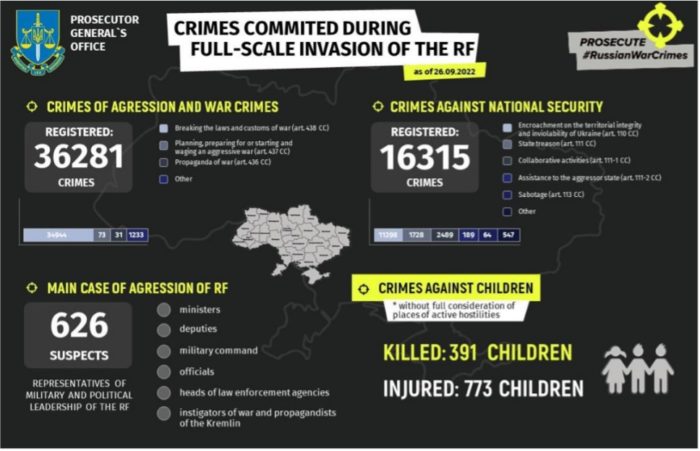
OHCHR recorded 14,844 civilian casualties in Ukraine as of September 26. 5,996 were killed (including 382 children) and 8,848 injured (including 676 children).
https://twitter.com/EuromaidanPress/status/1574335189815332865
Environmental
As wildfires grow, militaries are torn between combat and climate change, The Washington Post reports. “European militaries are fighting fires this summer that are burning with ever greater scope and intensity, battling record blazes across a continent that is also seized by war in Ukraine and the need to defend against an increasingly dangerous Kremlin. From the high cliffs of Portugal to the stony mountains of Greece, militaries have been the wildfire responders of last resort, bringing air resources and logistical capabilities that far outmuscle their civilian counterparts.
The twin problem — the war in Ukraine and natural disasters tied to global warming — underscores how climate change can weaken social stability, even when challenges at first glance appear unrelated. Russian President Vladimir Putin’s war in Ukraine is making it harder for European militaries to fight wildfires — and the worsening wildfires are making it harder for the militaries to respond to the Kremlin.
In this situation with Ukraine and wildfires, we are in a dilemma how to balance, Major General Robert Glavaš, the commander of Slovenia’s military forces, said in an interview. […] The challenge is also increasing in the United States, where National Guard members devoted more than 172,000 personnel days to fighting fires last year, compared to 18,000 in 2019, according to US Army figures.
But the task is especially pressing in Europe, where militaries shrank for years following the breakup of the Soviet Union. Now they are scrambling to expand to counter the threat of a possible Russian invasion and to rush aid to Ukraine to keep it in the fight. Some generals say that in a warming world, militaries will increasingly have to go beyond their traditional combat-focused operations to face climate-driven demands, such as responding to fires and floods.
The role of the military will not just be about fighting future enemies, but also about supporting civil authorities in dealing with the effects of climate change, said Tom Middendorp, a former top commander of the Dutch military who is now chairman of the International Military Council on Climate and Security, a research group that focuses on the security consequences of global warming.
Slovenian defense leaders decided this month to cancel a $343 million purchase of armored troop carriers as they contemplate buying more aircraft that could be used to fight fires. The discussions aren’t directly connected, but policymakers also say they need to make the best use of limited resources. The country donated 35 Yugoslav-era infantry combat vehicles to Ukraine in June.
Slovenian leaders say they need to prepare their military for a future in which there are more intense wildfires. They want to make it easier for the armed forces to get involved in disaster deployments. And they want to invest in military equipment that can also be used for firefighting. […]
But military leaders say the dual-headed challenge can sometimes be significant, and even contradictory. Our training is going on in a military way. Exercises. How to use military equipment, how to fight, how to protect. How to defend, said Glavaš, the head of Slovenia’s military command. When you stop this training and you go to civilian tasks you need to focus your mind from fighting to something else. It’s very hard sometimes. He said that fighting fires “definitely” had an impact on combat readiness.
So far this year, wildfires have consumed almost 3,000 square miles of territory in the 27 nations that make up the European Union — far outpacing the previous maximum of 2,300 square miles as of Sept. 17. Europe began collecting wildfire data in 2006. This year’s wildfires are nearly three times bigger than the average between 2006 and 2021. […]
“We have witnessed this summer an alarming acceleration and spread of wildfires,” Janez Lenarčič, the European Union’s top official for crisis management, told top European policymakers this month. He has pushed to expand the pool of E.U.-funded planes available for firefighting. “All these disasters are reinforced by the new reality of climate change, and we need to tackle that jointly.”
The fire in Slovenia started July 17 in the mountains that push up against the village of Kostanjevica na Krasu, a settlement of about 300 people who live around a few winding streets. […] The fire needed to be fought from the sky — so the military was called in to supplement civilian firefighting aircraft with helicopters and heat-imaging drones. In the end, seven nations deployed their militaries to help Slovenia, including three that border Ukraine and have been nervous about the war spilling over their borders. Slovakia sent a Black Hawk military helicopter. Romania sent three air force planes. Hungary sent two combat helicopters with a crew of 13 people. […]
On the ground, soldiers organized many of the firefighting logistics, including driving tankers of water close to the front lines and cooking meals for civilian firefighters and displaced residents. More than 200 members of Slovenia’s armed forces were deployed on the ground, of a total military force of about 5,900.
“The whole cooperation with the military was larger than ever before,” said Budal, who has been a firefighter for 40 years. […]
Security policymakers say they recognize the growing challenge of responding both to traditional threats, such as Russia, and faceless ones, such as climate change. NATO has made climate change an increasingly central part of its discussions in recent years at the same time it has been scrambling to respond to the war in Ukraine.
Climate change poses a serious risk to countries in the alliance, and we need to use our collective power to address that risk,” said Erin Sikorsky, a former top US intelligence official focused on climate change who is now the director of the Center for Climate and Security, a Washington-based research center. I think that does create some debate or tension between countries in NATO as they work it out.
This summer, Sikorsky started keeping a record on Twitter of countries that deployed their militaries to fight fires, floods or other climate-related natural disasters. Her list, so far, is 49 emergencies long, from Argentina to Pakistan to Bulgaria to Jackson, Miss. You’re seeing it more and more in all different parts of the world, Sikorsky said.”
Legal
https://twitter.com/EuromaidanPress/status/1574413188610883584
Ukraine's Zelenskyy says two more burial sites were found in liberated Izium, Reuters reports. “Ukraine has discovered two more mass burial sites containing the bodies of hundreds of people in the northeastern town of Izium, which Kyiv recaptured from Russia this month, Ukrainian President Volodymyr Zelenskyy said.
Zelenskyy made his comment in an interview with CBS published late on Sunday in which he also called for sustained sanctions pressure on Russia, whose troops were routed in northeastern Ukraine in a lightning counteroffensive this month.”
Another Russian torture chamber was discovered in the Kharkiv region, Ukrinform reports, citing the Prosecutor General's Office. "On September 23, prosecutors of the Derhachiv district prosecutor's office in Kharkiv region, together with law enforcement officers discovered in the village of Liptsi, Kharkiv district, the office of the so-called ‘LNR police,’ where the Russian military and that of the pseudo-Republic had been based, the statement reads. In the building’s basement, the invaders held people, subjecting them to torture before taking them to the Russian territory, according to tentative reports.
The inquiry is being conducted within the framework of criminal proceedings initiated over the violation of the laws and customs of war (Part 1 of Article 438 of the Criminal Code of Ukraine).”
A draft document establishing Special International Tribunal to punish Russia circulated to 30 foreign ambassadors – Zelenskyy, Ukrainska Pravda reports. "An important political and diplomatic event took place at the Office [of the President] today. A draft document establishing a Special International Tribunal to punish Russia for the crime of aggression against our state was presented to the ambassadors of 30 states, our partner [states, President Zelenskyy] said."
Zelenskyy said that it is difficult to prosecute Russia for its crimes in Ukraine because the available international legal mechanisms are not sufficient. He said that a Special International Tribunal was needed: [W]e are meticulously and carefully working on this draft […] Everyone who unleashed this criminal war against Ukraine and freedom in Europe will be brought to account."
395 children were killed, 776 children injured, 7,820 deported by foe forces, and 240 reported missing - the Office of the Prosecutor General of Ukraine reports as of September 27. 2,500 educational establishments are damaged as a result of shelling and bombings, 289 of them are destroyed fully. 36,161 crimes of aggression and war crimes and 16,288 crimes against national security were registered
1.5 million forcibly deported Ukrainians can’t return home from Russia - Deputy PM Olga Stefanishyna
Ukrainian women and children, are currently in Russia without the possibility of returning home, and their relatives cannot establish contact with them.https://t.co/MpttR3bFDd
— Euromaidan Press (@EuromaidanPress) September 26, 2022
Support
German Association "We are Europe" launches "Tanks of Freedom" petition urging Scholz to take the lead in supplying modern Western IFVs & battle tanks to Ukrainehttps://t.co/ITsmDKOhfj pic.twitter.com/fqDG8Ba42f
— Euromaidan Press (@EuromaidanPress) September 26, 2022
Zelensky's Office Explained Situation with NASAMS: Not Yet in Ukraine, European Pravda reports. “The spokesman of the President of Ukraine, Volodymyr Zelensky, explained his statements to an American TV channel that Ukraine had received NASAMS anti-aircraft missile systems. Serhii Nikiforov made it clear it was a decision to hand them over.
We have received a positive decision. We have received consent. NASAMS itself has not yet physically arrived, spokesman Serhii Nikiforov commented to Suspilne. In mid-September, the Pentagon reported that Ukraine would receive the first two NASAMS SAM batteries within the next two months.”
US to allocate $457.5M in security assistance to Ukraine – Blinken, Ukrinform reports, citing the US Secretary of State Antony Blinken. "The United States will provide an additional $457.5 million in civilian security assistance to save lives and bolster the capacity of our Ukrainian law enforcement and criminal justice partners, he wrote. Blinken noted that the United States shares the Ukrainians' commitment to a democratic, independent, and sovereign Ukraine.
Ukraine's Prime Minister Denys Shmyhal earlier said that the Cabinet of Ministers plans that in 2023 Ukraine will be able to attract $12 billion from the IMF and EU and $18 billion from the United States.”
New Developments
https://twitter.com/EuromaidanPress/status/1574417712180330502
- Putin wants the West to respect Russia, Ukrainska Pravda reports, citing Belta and RIA Novosti. “Aliaksandr Lukashenka, the self-proclaimed president of Belarus, has said at a meeting with Russian leader Vladimir Putin that Russia and Belarus would not tolerate humiliation from Europe, although the future lies with cooperation; meanwhile, Putin has called on the West to respect Russia.”
- British MP says Russia should be stripped of UNSC seat, Ukrinform “Russia should not be part of the UN Security Council, let alone have a veto right in the body. That’s according to Sir Roger Dale, Member of the British House of Commons, who spoke with Guildhall.”
- Putin knows negotiations will be impossible after sham referendums – Zelenskyy, Ukrainska Pravda reports, citing CBS News. "The Russian government can officially announce that the referendum has been completed, and the results will be announced. This would make it impossible, in any case, to continue any diplomatic negotiations with the President of the Russian Federation, and he knows it very well. I have spoken about it publicly. I think it's a very dangerous signal from President Putin that tells us that he is not going to end this war."
- Türkiye working to organize a Zelensky-Putin meeting – Cavusoglu, Ukrinform "There must be a just peace, of course, especially for Ukraine. Because the lands occupied (by Russia) belong to Ukraine. Of course, actors who want the war to continue outside of these two countries also need to be convinced. As Türkiye, we have not lost hope. We are increasing and continuing our efforts. Our goal is a meeting of both leaders and decision-making at the level of the leaders, [Turkish Foreign Minister Mevlüt] Çavuşoğlu said.”
- President's Office says additional mobilization is possible if necessary, Ukrainska Pravda Mykhailo Podoliak, Adviser to the Head of the Office of the President, said that the issue of additional mobilization in Ukraine will depend on the situation at the front and what effect the mobilization in Russia will have.
- UK sanctions collaborators of Russia's illegal sham referendums, Ukrinform reports, citing a press release from the UK government. "Today's sanctions will target those behind these sham votes, as well as the individuals that continue to prop up the Russian regime's war of aggression. We stand with the Ukrainian people and our support will continue as long as it takes to restore their sovereignty, said Foreign Secretary James Cleverly.”
- Kazakhstan says it won't recognize Russian pseudo-referendums in Ukraine, Ukrinform reports, citing Reuters. “Kazakhstan will not recognize the possible annexation of Ukrainian territories captured by Russia through sham referendums held there. The Ministry of Foreign Affairs of Kazakhstan said this on Monday.”
Assessment
- On the war.
The Institute for the Study of War has made the following assessment as of 26 September 2022:
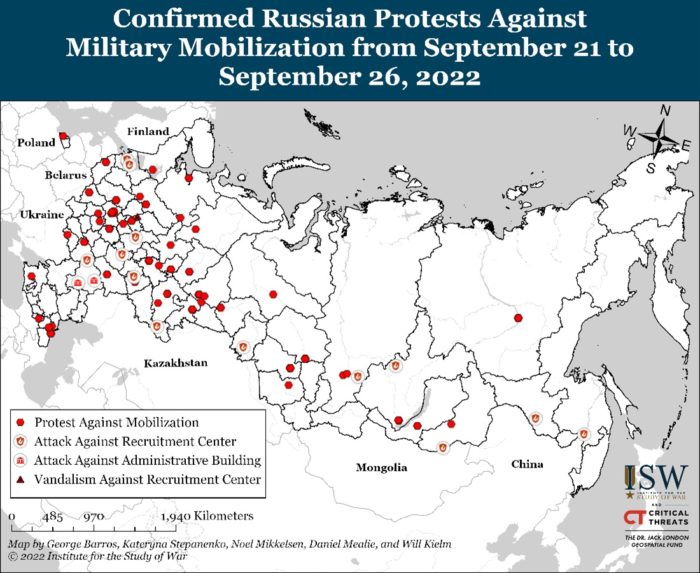
“The Kremlin is attempting to message its way out of the reality of major problems in the execution of its “partial mobilization,” but its narratives are unlikely to placate Russians who can perceive the real mistakes all around them. The Kremlin is deflecting blame for the Russian government’s failure to abide by its own stated criteria for mobilization and exemptions onto the failing bureaucratic institutions responsible for the mobilization. The Kremlin is downplaying the widespread violations of the mobilization law as individual errors of local authorities, claiming to correct these errors as citizens call attention to them. The violations are clearly too common to be merely the result of individual errors, however, and Russian citizens can see them all too clearly. Unlike Russian failures in Ukraine, which the Kremlin has been able to minimize or deflect because its citizens cannot see them directly, violations of the mobilization decree are evident to many Russians. Word of these violations does not even require access to media or social media, because they are occurring in so many locations and victims’ families can spread their anguish by word of mouth.
Russian state media has begun acknowledging social media complaints of persistent problems with the mobilization process, largely pinning the blame on the supposedly unmotivated and careless employees of the military recruitment centers. Russian propagandists and heads of federal subjects are actively discussing instances of wrongful mobilization of men older than the maximum mobilizable age, those who had never served, and those who have medical conditions, as well as poor treatment of mobilized individuals. Omsk Oblast Governor Alexander Burkov declaimed that the bureaucracy is the “enemy of patriotism” and blamed bureaucrats for focusing on meeting unstated quotas rather than correctly fulfilling Russian President Vladimir Putin’s partial mobilization order. One state television host threatened to punish workers of military recruitment centers if they fail to abide by the limited reservist mobilization order. The Kremlin’s media outlets and voices are increasingly sharing individual stories in which military recruitment centers released some men who were unfit for service following the involvement of local officials or with the help of Kremlin state media to suggest that errors are being corrected when called to the Kremlin’s attention.
The Kremlin faces a daunting task in trying to calm the Russian people while still mobilizing enough men to keep fighting. The Kremlin’s current narrative aims to assuage its distraught and panicking population with the promise of fixing and punishing bureaucratic institutions for widespread “mistakes” in the mobilization campaign, but such messaging is unlikely to solve the Kremlin’s problems. Putin will have to fix (or convincingly appear to fix) the mobilization bureaucracy sprawling across 11 time zones while simultaneously getting it to meet the mobilization quotas he has set for it to support the war effort. These imperatives are likely mutually exclusive in a short period of time. The Kremlin also risks further undermining this critical bureaucratic institution during an important period by continuously blaming it for failures that are likely not entirely of its making. Some Russians are already directing their anger onto enlistment officials; a man who opposed mobilization shot the head of the Ust-Ilimsk military recruitment office in Irkutsk Oblast on September 26.
The Kremlin’s efforts to calm the Russian population are struggling so far, as protests occurred in at least 35 settlements on September 25 and at least 10 settlements on September 26. Russian police continue to suppress protests, notably detaining several hundred women in Yakutsk, Republic of Sakha. Russian police also fired warning shots at anti-mobilization protestors in Endirei, a village of approximately 7,900 people in the Republic of Dagestan. Russians set Russian military enlistment centers on fire in Uryupinsk, Volgograd Oblast and Ruzaevka, Mordovia Republic. A detained student also attempted to set on fire a building that had a military registration and enlistment office sign in St. Petersburg even though the building itself was not a military enlistment office. Some mobilized men harmed themselves to protest the mobilization, with one Russian man setting himself on fire in Ryazan Oblast.
The Kremlin is executing a declared reserve partial mobilization as if it were partial conscription, exacerbating societal discontent. A normal selective mobilization of reserves would have the government call up reservists based on lists of those who have military experience (the primary prerequisite for membership in Russia’s less-than-formal reserve system) and are in the correct age bracket. The Kremlin, as well as nationalist Russian milbloggers, have repeatedly claimed that military enlistment centers throughout Russia are doing just that—using such preexisting lists of known reservists to mobilize eligible men. A Russian milblogger cited a Russian Ministry of Defense source on September 26, however, who claimed that all Russian citizens are responsible for pre-emptively providing documentation of their ineligibility for mobilization to the military recruitment centers. If they do not provide documentation, they risk being mobilized. That process is standard for conscription, but unorthodox for an alleged selective mobilization of reserves. The Kremlin has most likely set quotas for local officials to fill and emphasized meeting those quotas over abiding by the legal guidelines for mobilization eligibility, leading to the prioritization of numbers over adherence to the law and thus to the forced mobilization of men with no military experience or with other disqualifying health conditions.
Even a competently executed call up of Russia’s reserves would be unlikely to generate significant combat power in Ukraine in the near term. Financially motivated MoD reforms that reduced the term of conscripts’ service from two years to one in 2008 mean that those conscripted since 2008 were not trained to a level of competence that would make them useful force-multipliers for Russia’s current efforts without considerable additional training. The MoD does not appear to have taken steps to render these new recruits useful, however. Russian reports from a Russian training center in Sergeyevsky claimed that newly mobilized men wandered around the center without training, equipment, or officers for four days.
The Kremlin’s planned annexation of occupied Ukraine may take place before or shortly after October 1, the start of Russia’s normal fall conscription cycle, to enable the forced conscription of Ukrainian civilians to fight against Ukraine. If it does, the Kremlin will likely order the Russian Ministry of Defense to include Ukrainian civilians in occupied and newly annexed Ukrainian territory in the Russian conscription cycle, broadening the forced mobilization of Ukrainian civilians to fight against Ukraine. ISW has previously assessed that one motivation for Putin to order mobilization and annexation in concert with one another is to broaden the forced mobilization of Ukrainian civilians, but those civilians do not meet the legal criteria for the Kremlin’s current partial mobilization order—almost none of them in the mobilizable age categories are likely to have experience in the Russian military. As “Russian” citizens under Russian law, however, all Ukrainian men between 18 and 27 years old in annexed territories would become eligible for conscription. A Russian milblogger claimed on September 26 that the Russian Ministry of Defense will build a branch of the Nakhimov Naval School in occupied Mariupol, Donetsk Oblast, demonstrating the extent to which the Russian military intends to embed itself in occupied Ukrainian territory.
Russian officials have already mobilized Ukrainian citizens to fight against Ukraine. The Russian-appointed occupation governor of Russian-annexed Sevastopol, Mikhail Razvozhaev, claimed on September 25 that Russian authorities mobilized around 2,000 men in occupied Crimea and Sevastopol as part of Putin’s partial mobilization. As ISW has previously reported, Russian occupation authorities have previously forcibly mobilized Ukrainian civilians from all occupied Ukrainian oblasts in smaller numbers.
Russian authorities have already set conditions to mobilize Ukrainian men in larger numbers after annexation is formalized. The Ukrainian advisor to the Kherson Oblast Military Administration, Serhiy Khlan, reported on September 25 that Russian occupation authorities are not allowing men under 35 years old to leave occupied Kherson. The Ukrainian mayor of occupied Melitopol, Ivan Fedorov, reported on September 26 that the Kremlin instructed the Russian Melitopol occupation administration to form a volunteer battalion of 3,000 members by October 10. The Ukrainian head of the Luhansk Oblast Military Administration, Serhiy Haidai, reported on September 26 that Russian occupiers in Svatove, Luhansk Oblast issued mobilization orders to all men in the area and that Russian authorities in annexed Luhansk will similarly mobilize all Ukrainian men.
Unconfirmed reports suggest Ukrainian forces may have destroyed a Russian drone control and training center that directed drone attacks against Ukraine, possibly killing Iranian trainers. Ukrainian journalist Andriiy Tsapienko claimed that Ukrainian forces avenged Russian drone attacks on Odesa by striking the Russian facility in Chulakivka on the Kinburn Spit of Kherson Oblast on September 26 and claimed that the Ukrainian strikes killed four dozen Russians and two dozen Iranian trainers teaching Russian forces how to use Iranian-made drones like the Shahed-136. Russian forces have used Iranian-made Shahed-136 munitions to strike targets in Odesa in recent days, as ISW has previously reported. ISW cannot independently confirm Tsapienko’s reporting, and Ukrainian government sources did not report an attack on a drone command center. […] The spit is the westernmost land the Russians still control in the Black Sea within 4 km of Ukrainian-controlled Ochakiv at its closest point, making it an excellent location for a drone command center from which Russia could direct attacks deep into unoccupied Ukraine.
Key Takeaways
- The Kremlin is attempting to message its way out of the reality of major problems in the execution of its “partial mobilization,” but its narratives are unlikely to placate Russians who can perceive the real mistakes all around them.
- The Kremlin’s planned annexation of occupied Ukraine may take place before or shortly after October 1, the start of Russia’s normal fall conscription cycle, to enable the forced conscription of Ukrainian civilians to fight against Ukraine.
- Ukrainian forces continued to make advances north of Lyman and on the eastern bank of the Oskil River.
- Ukrainian forces continued to target Russian ground lines of communication (GLOCs) as part of the southern counter-offensive interdiction campaign.
- Russian forces continued conducting offensive operations around Bakhmut and west of Donetsk City.
- Russian forces continued to use Iranian-made drones to strike Ukrainian forces and cities in southern Ukraine.
- The Kremlin may be considering formally closing its borders or more formally restricting the movement of fighting-age men within the country to better implement partial mobilization.
Russian occupation authorities began to announce the results of their sham annexation referenda, citing flagrantly falsified turnout numbers.“
The US is seeing no signs of Russia preparing nuclear attack - White House, Ukrinform reports, citing White House spokesperson Karin Jean-Pierre. “The United States is currently observing no signs of preparations for the use of nuclear weapons by Russian forces while taking Vladimir Putin’s latest threats very seriously.”
"Russian people must unite in the face of NATO threat": Russian media reveal new guide from Kremlin, Ukrainska Pravda reports. “Russian propaganda received a new guide on explaining mobilisation and war with Ukraine. The document states that Russia won wars... only when the Russians believed that it was a ‘people's war’ going on. Therefore, the compilers of the propaganda guide conclude that one main thesis should be conveyed to the Russians now: ‘Russian people must unite in the face of the threat of NATO’. According to the Kremlin, the Alliance intends to ‘disintegrate and rob’ Russia.
It is also suggested to emphasise that the front line is over 1,000 km long, and therefore the entire "burden of war" should not be put on the contract soldiers and the "people's militia of Donbas". The authors of the guide pose explosions on Russian borderline territories and in Crimea, which was annexed by Russia in 2014, as other reasons for the mass recruitment of people to war against Ukraine.
It is proposed to emphasise that Russia is not at war with Ukraine, but with NATO", and that "the West has forbidden Kyiv to negotiate with Russia.
The Kremlin is making special emphasis on the fact that the draft will allegedly affect only "1% of the registered military personnel". The call-up is referred to as "minimal", and the guide authors emphasise that only "experienced men who have served in the army" will be mobilised.
According to two sources of Medusa that are close to the Russian President’s Office, all of this, according to the Kremlin's plan, should oppose the negative reaction of the Russians to the ongoing conscription. In addition, the Russian authorities want to "redirect the anger" of the conscripts and their relatives to the military enlistment offices.”
Russia preparing massive cyberattacks on Ukraine’s critical infrastructure – intelligence, Ukrinform reports, citing the Defence Intelligence of Ukraine (DIU). "The Kremlin is planning to carry out massive cyberattacks on the critical infrastructure facilities of Ukrainian enterprises and critical infrastructure institutions of Ukraine's allies. Attacks will be aimed at energy sector enterprises. The experience of cyberattacks on Ukraine's energy systems in 2015 and 2016 will be used when conducting operations, the report reads.
Russian forces will try to increase the effect of missile strikes on electricity supply facilities, primarily in the east and south of Ukraine. The command of the Russian Federation is convinced that this will slow down the offensive operations of the Ukrainian Defense Forces.
The Kremlin also intends to increase DDoS attacks on the critical infrastructure of Ukraine's closest allies, primarily Poland and the Baltic states.
As Ukrinform reported, at the end of August, the State Service for Special Communications and Information Protection of Ukraine announced that in the six months since the start of the full-scale invasion, enemy hackers had attacked Ukraine 1,123 times.”
Men are not allowed out of Russia, documents are required from the military enlistment office, Ukrainska Pravda reports, citing Nastoyashcheye Vremya and The Bell. "The military enlistment office provides the border department with a list of citizens who are restricted from leaving [the country - ed.]. In order to cross the border, these categories of people need a document - a permit to travel from a military enlistment office, received at the place where the citizen is registered."
Russia admits to draft problems as anger flares into violence, The New York Times reports. “In a rare admission of official mistakes, the Kremlin acknowledged on Monday that its new military draft to reinforce the Russian assault on Ukraine has been rife with problems. The admission occurred the same day that a man, apparently distraught over the mobilization, shot and seriously wounded a recruitment officer at a draft office in Siberia.
Since President Vladimir V. Putin of Russia announced a “partial mobilization” last week to call up 300,000 people with military experience to join the fight, there have been widespread reports of conscription in rural regions that have swept up ethnic minorities and, it appears, people unfit for duty. Protests have erupted in far-flung cities, recruitment centers have been the target of arson, and thousands of military-age men have packed planes and vehicles to flee across Russia’s borders.
The Kremlin’s spokesman, Dmitri S. Peskov, acknowledged on Monday that there had been irregularities in the call-up, but he tried to shift blame to the local authorities carrying out the mobilization among resistant civilians across the country.
There are cases when the decree has been violated, Mr. Peskov told reporters during a daily phone call. In some regions, governors are actively working to correct the situation. The governors of several Russian regions - including Belgorod, Kostroma, Vladimir, Yakutia and Magadan in the far east — have acknowledged that men who did not meet the defense ministry’s criteria are being called up. Mr. Peskov said the problems were being addressed. […]
Mr. Putin has moved to escalate the war effort. The sudden reversal surprised many Russians and led to widespread rumors that the authorities would close the borders to keep men of military age in the country. But since last Wednesday, an estimated 261,000 men have fled Russia, according to the independent newspaper Novaya Gazeta, which cited sources in the Russian security services. […]
Michael Kofman, the director of Russia studies at C.N.A., a defense research institute based in Virginia, said on Monday that the regional agencies calling up Russian men were trying to fill quotas and, apparently, conscripting them without regard to qualifications. […]
Russia’s goal, Mr. Kofman said, appears to be getting troops quickly to the battlefield to stabilize its defensive lines and prevent another Ukrainian counterattack before winter sets in. He said a large enough draft could bolster Moscow’s ability to sustain the war, but noted that because the military had already deployed officers and enlisted professionals months ago, it lacked trainers for the new draftees.
I think they’re going to, at best, get two weeks of refresh or some kind of familiarization training before being sent off, Mr. Kofman said. We’re very much in uncharted waters regarding the implications of it and how it will go. […].
Putin’s debacle is breaking his country — and he might pay the price, the Editorial Board of The Washington Post argues. “Like so much else in Russian President Vladimir Putin’s senseless and vicious assault on Ukraine, his attempt to mobilize Russian men to fight has turned into a debacle. After months of preserving relative calm about the war among the Russian public — through a combination of propaganda, lies, censorship and harsh punishment of criticism and dissent — Mr. Putin has broken the quiet himself. Thousands of Russian men are running for the exits.
Mr. Putin had announced a “partial mobilization,” saying that “only military reservists, primarily those who served in the armed forces and have specific military occupational specialties and corresponding experience, will be called up.” But in recent days, the call-up has grabbed men with no prior military service, including some who are too old or physically incapable of going to war. Moreover, the burden is falling more heavily on small towns and villages and among ethnic minorities.
Outright protest — and chaos — erupted. In the Irkutsk region, a young man shot the chief recruitment officer at a military enlistment station. In Omsk, social media video showed, fighting broke out between drafted men and the police officers forcing them onto buses. The draftees called on the police to die with them in the trenches. Arson attacks have hit recruitment offices in 16 regions since Mr. Putin’s announcement last Wednesday, nearly twice as many incidents since the Russian president launched the invasion in February. Since the call-up announcement, more than 2,300 people have been arrested for protesting. A traffic jam of 2,300 vehicles backed up at the border crossing between Russia and Georgia as men fled the draft, while many others walked and thousands more fled through Finland and other routes. Almost all flights out have been booked for days.
Behind the upheaval is a deeper fissure. For many years, Mr. Putin maintained what scholar Masha Lipman dubbed a “no-participation pact” with a swath of the Russian public: These people agreed to stay out of politics in exchange for the government not interfering in their daily lives. After the war began, many Russians kept quiet or just tried to ignore it; mass protests did not break out. But the mobilization threatens to destroy this compact. Sociologist Greg Yudin notes that Mr. Putin did not initiate a political mobilization before launching the military one. He says Russians are quickly snapping out of lethargy and asking questions that they hadn’t for a long time. This might weaken Mr. Putin still more. Ukraine and its allies must keep the pressure on.
Once again, Mr. Putin’s lies and absurdities fall before the truth. The “partial mobilization” of reservists turns out to be a desperate grab for canon fodder. The “referendums” in captured territory are a travesty of democracy. The “special military operation” turns out to be a long and painful war. Mr. Putin lashes out at “neo-Nazis,” but his own troops stand accused of the most horrible war crimes.
The darkest truth is that Mr. Putin — the aggressor, the lone reason for this war — has wasted tens of thousands of lives for nothing and now threatens to add more atop a dismal pile of shame.”
Consequences and what to do?
"I don't think he's bluffing": Zelenskyy on Putin's nuclear blackmail, Ukrainska Pravda reports, citing CBS. “Margaret Brennan, the presenter of Face the Nation TV program asked Zelenskyy whether he thought that Putin was bluffing when he threatened to use nuclear weapons.
"Look, maybe yesterday it was bluff. Now, it could be the reality. Let's look, what [does the] use of nuclear weapons or nuclear blackmail [look like under the current circumstances]? He targeted and occupied our nuclear power plant and the city of Enerhodar. This nuclear station has six [power units] […] This is [the equivalent] of six Chornobyl nuclear [power] plants. Several days ago, they started shooting at another nuclear power plant. It's called Pivdenna, or Southern, Nuclear Power Plant. The missile hit the area that was 300 metres from the nuclear plant. [A]ll windows and doors [at the power plant have shattered]. So, he wants to scare the whole world. These are the first steps of his nuclear blackmail. I don't think he's bluffing. I think the world is deterring it and containing this threat. We need to keep putting pressure on him and not allow him to continue."
War in Ukraine will have a greater impact on the world economy – OECD, Ukrinform reports. The Organization for Economic Co-operation and Development (OECD) believes that Russia's war in Ukraine, now in its eighth month, will have a greater impact on the world economy than it was earlier anticipated, the organization said this in its report.
"The world economy is paying a high price for Russia's unprovoked, unjustifiable and illegal war of aggression against Ukraine," the OECD said, noting that the organization lowered its global economic growth forecast to 2.2 percent in 2023 from a previous estimate of 2.8 percent. The report notes that the war is dragging down growth and putting additional upward pressure on prices, above all for food and energy.
The OECD said that global GDP stagnated in the second quarter of 2022 and output declined in the G20 economies. In addition, the report said that high inflation is persisting for longer than expected. In many economies, inflation in the first half of 2022 was at its highest since the 1980s. With recent indicators taking a turn for the worse, the global economic outlook has darkened, the organization said.”
Hans Petter Midttun: The OECD report should not come as a surprise to anyone. I have been warning about the “tsunami of ripple effects” from the war since the very start of the invasion.
After the failed attempt to conclude the war through a “Blitzkrieg” – an abnormality in what has been a long-term strategy since 2014 – the war reverted to its original hybrid war strategy in April. This is the synchronized and parallel use of both non-military and military means to destabilize both Ukraine and the West.
NATO has seemingly accepted a protracted war despite its many devastating effects.
That is also why I questioned NATO’s strategy in my daily report on 4 July. The present strategy only makes sense if a protracted war is seen as a “positive outcome” or the lesser of evils.
Why do we keep idle in the fear of a hypothetical catastrophe while accepting a multitude of real catastrophes? Why do we accept the deaths and suffering of Ukrainians and the destructions of Ukraine alongside the crumbling international security architecture? Why do we accept increased global poverty and famine because of the war? Russia threatening the world with a nuclear catastrophe as it wages war around Ukraine’s 15 Nuclear Power Plants? Reduced energy and food security? Recession and increased costs of living? A growing level of frustration in populations, and consequently, the risk of demonstrations, riots, increasing extremism and the fall of governments? Why do we accept running the risk of experiencing the 1930s all over again?
These aspects are being addressed in a separate article.


